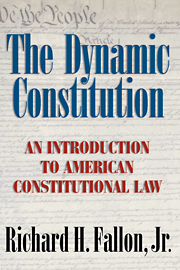Book contents
- Frontmatter
- Contents
- Preface
- Prologue: Bush v. Gore
- Introduction: The Dynamic Constitution
- Part I Individual Rights Under the Constitution
- Part II The Constitutional Separation of Powers
- Part III Further Issues of Constitutional Structure and Individual Rights
- 10 Elections, Political Democracy, and the Constitution
- 11 Structural Limits on State Power and Resulting Individual Rights
- 12 The Constitution in War and Emergency
- 13 The Reach of the Constitution and Congress's Enforcement Power
- 14 Conclusion
- Appendix: The Constitution of the United States
- Notes
- Index
14 - Conclusion
Published online by Cambridge University Press: 25 July 2009
- Frontmatter
- Contents
- Preface
- Prologue: Bush v. Gore
- Introduction: The Dynamic Constitution
- Part I Individual Rights Under the Constitution
- Part II The Constitutional Separation of Powers
- Part III Further Issues of Constitutional Structure and Individual Rights
- 10 Elections, Political Democracy, and the Constitution
- 11 Structural Limits on State Power and Resulting Individual Rights
- 12 The Constitution in War and Emergency
- 13 The Reach of the Constitution and Congress's Enforcement Power
- 14 Conclusion
- Appendix: The Constitution of the United States
- Notes
- Index
Summary
[The] constitution [was] intended to endure for ages to come, and consequently, to be adapted to the various crises of human affairs.
– Chief Justice John MarshallI have a dream.
– Dr. Martin Luther King, Jr.In the introductory chapter, I emphasized that this would be a book about American constitutional practice – not just about the Constitution as a written text, but about the social, cultural, and political processes through which constitutional law emerges. To a large and possibly excessive extent, the Supreme Court has tended to dominate the book, because the Court stands center stage in the production of constitutional doctrine. But the Court is not the only actor in the drama. In this concluding chapter, I therefore want to step back from the details of constitutional doctrine and offer a few summary theses about the role of the written Constitution and the Supreme Court in our constitutional practice.
Our Constitution is a dynamic document, which draws its meaning partly from evolving thinking and the pressure of events. In the course of this book, I have offered many illustrations of this claim, involving (among others) the historical flow of power to the executive branch, the scope of congressional power under the Commerce Clause, the expansive reach of currently recognized rights to freedom of speech and association, and the interpretation of the Equal Protection Clause.
- Type
- Chapter
- Information
- The Dynamic ConstitutionAn Introduction to American Constitutional Law, pp. 269 - 277Publisher: Cambridge University PressPrint publication year: 2004



